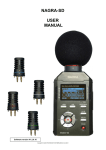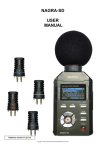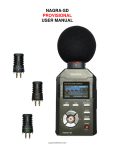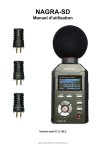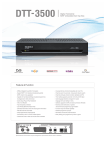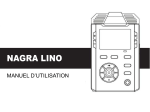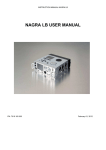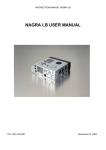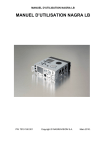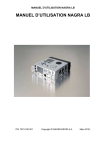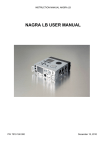Download NAGRA-SD USER MANUAL
Transcript
NAGRA-SD USER MANUAL Software version V1.2.0.5 Copyright © NAGRAVISION S.A.2011 1 GUARANTEE ........................................................................................................................................................ 4 2 DELIVERED WITH ............................................................................................................................................................. 4 3 PANEL DESCRIPTION ...................................................................................................................................................... 5 3.1 Front panel key functions ................................................................................................................................... 5 3.2 Rear side ............................................................................................................................................................ 6 3.3 Left side .............................................................................................................................................................. 6 3.4 Right side ........................................................................................................................................................... 6 3.5 Top face ............................................................................................................................................................. 6 4 INSTALLING BATTERIES ................................................................................................................................................. 6 5 FIRST POWER ON ............................................................................................................................................................ 6 6 RECORD WINDOW DESCRIPTION ................................................................................................................................. 7 6.1 View .................................................................................................................................................................... 7 6.2 Input type ............................................................................................................................................................ 7 6.3 Input / record level .............................................................................................................................................. 7 6.4 AGC status ......................................................................................................................................................... 7 6.5 Output volume .................................................................................................................................................... 7 6.6 VOR status ......................................................................................................................................................... 7 6.7 Modulometer ...................................................................................................................................................... 7 6.8 Play / Record file name ...................................................................................................................................... 7 6.9 Play / Record counter ......................................................................................................................................... 7 6.10 Total file / Free record time .............................................................................................................................. 7 6.11 Cue counter, Cue position ................................................................................................................................ 7 6.12 Run status ........................................................................................................................................................ 7 6.13 Audio parameters ............................................................................................................................................. 7 6.14 USB status ....................................................................................................................................................... 8 6.15 Keyboard status ............................................................................................................................................... 8 6.16 Battery status ................................................................................................................................................... 8 7 USING THE NAGRA-SD .................................................................................................................................................... 8 7.1 Recording in the field.......................................................................................................................................... 8 7.1.1 Adjusting input levels ......................................................................................................................... 8 7.1.2 The Automatic Gain Control (A.G.C).................................................................................................. 9 7.1.3 Cue points during record .................................................................................................................... 9 7.2 Playback of a previous recording ....................................................................................................................... 9 7.2.1 Adjusting playback levels ................................................................................................................... 9 7.3 Cue point selection during play .......................................................................................................................... 9 7.4 Storing settings in a template (High, Low Quality) ............................................................................................. 9 7.5 Deleting an audio recording rapidly.................................................................................................................. 10 7.6 Downloading to a computer ............................................................................................................................. 10 8 FILES & WORKING FOLDER .......................................................................................................................................... 10 9 MENUS............................................................................................................................................................................. 11 9.1 Record settings ................................................................................................................................................ 13 9.1.1 Templates ......................................................................................................................................... 13 9.1.2 Matrix ................................................................................................................................................ 14 9.1.3 Pre-record ........................................................................................................................................ 14 9.1.4 VOR .................................................................................................................................................. 14 9.1.5 Input device ...................................................................................................................................... 14 9.1.6 Prefix name ...................................................................................................................................... 14 9.2 System settings ................................................................................................................................................ 14 9.2.1 Time & Date ..................................................................................................................................... 14 9.2.2 Record LED ...................................................................................................................................... 15 9.2.3 Beep settings.................................................................................................................................... 15 9.2.4 Speaker settings............................................................................................................................... 15 9.2.5 Auto skip........................................................................................................................................... 15 9.2.6 Display extinction ............................................................................................................................. 15 9.2.7 Auto power off .................................................................................................................................. 15 9.2.8 Battery type ...................................................................................................................................... 15 9.2.9 USB write protection ........................................................................................................................ 15 9.2.10 Language settings .......................................................................................................................... 15 9.2.11 SD information................................................................................................................................ 15 9.2.12 SD speed test ................................................................................................................................. 15 9.2.13 Format ............................................................................................................................................ 15 9.2.14 Version ........................................................................................................................................... 15 9.2.15 System reset .................................................................................................................................. 15 9.2.16 System update ............................................................................................................................... 16 9.2.17 Export / Import the configuration .................................................................................................... 16 10 MICROPHONES AND SETTINGS. ............................................................................................................................... 17 Page 2 of 21 Copyright © NAGRAVISION S.A. 2011 August 22, 2011 11 LOW CUT FILTER OR NOT, ON THE NAGRA-SD ...................................................................................................... 17 12 AUDIO COMPRESSION (WHY AND WHEN TO USE IT). ........................................................................................... 17 13 USB ................................................................................................................................................................................ 18 13 CE NORM....................................................................................................................................................................... 19 14 SPECIFICATIONS ......................................................................................................................................................... 19 Page 3 of 21 Copyright © NAGRAVISION S.A. 2011 August 22, 2011 1 GUARANTEE Nagra / Kudelski certifies that this instrument was thoroughly inspected and tested prior to leaving our factory. We guarantee the products of our own manufacture against any defect arising from faulty manufacture for a period of two years from the date of delivery. This guarantee covers the repair of confirmed defects or, if necessary, the replacement of the faulty parts, excluding all other indemnities. All freight costs, as well as customs duty and other possible charges, are at the customer's expense. Our guarantee remains valid in the event of emergency repairs or modification being made by the user. However we reserve the right to invoice the customer for any damage caused by an unqualified person or a false manoeuvre by the operator. We decline any responsibility for any and all damages resulting, directly or indirectly, from the use of our products. Other products sold by KUDELSKI S.A. are covered by the guarantee clauses of their respective manufacturers. We reserve the right to modify the product, and / or the specifications without notice. 2 DELIVERED WITH The package includes: • • • • • • • 1 NAGRA-SD 1 USB cable 1 USB memory key (manual) 1 Carrying case 1 Carrying strap 1 SD card 2 GB Mono microphone input cable with XLR plug Optional: • • • • 2070 120 000 7070 121 000 7070 125 000 7070 122 000 Standard Stereo Cardioid clip-on microphone (red) High quality Omni Directional Mono clip-on microphone (blue) High quality stereo Cardioid clip-on microphone (green) High quality Cardioid Mono clip-on microphone (white) • 2070 005 000 Tripod for table top use • • • 7070 123 000 7070 127 000 7070 128 000 Stereo microphone input cable with XLR plugs Mono line input cable with XLR plug Stereo line input cable with XLR plugs Page 4 of 21 Copyright © NAGRAVISION S.A. 2011 August 22, 2011 3 PANEL DESCRIPTION 3.1 Front panel key functions 1 VIEW key • Permits to swap between different data displays (default display or file / rec format, date & time). • When pressed if the directory is shown on the display, it shows all details of the selected file. 2 CUE key • To enter cue points during record, to select the cue mode during playback. 3 FILES / MENU key • A short press selects the directory (folders), a long press selects the menus. 4A • • B key To enter 2 markers for a playback loop. Create a new file during recording. 5 DELETE key • Deletes the selected index. 6 POWER key • To turn on or off the Nagra-SD (Must be pressed for 3 seconds to avoid accidental operation). 7 DOWN key ▼ • Stops a record. • To move downwards in the directory or menus. 8 LEFT key ◄ • Rewinds during playback when pressed and held. • Skip backwards during stop or play. • In the menus, shifts to the left or quits them. • Selects left channel sensitivity adjustment in stereo mode. 9 UP key ▲ • Starts a playback. • Put the playback or record in pause mode. • In the menus or directory, shifts upwards. 10 RIGHT key ► • Forwards during playback when pressed and held. • Skip forwards to the next index during stop or play. • In the menus, shifts to the right. • Selects right channel sensitivity adjustment in stereo mode. 11 RECORD key (centre key) • Put the machine in EE mode (LED starts blinking slowly). • Starts a record. (LED continuously on). • In the menus, executes a selection. 12/13 INPUT LEVEL keys • Decreases (12) or increases (13) the input sensitivity. • In combination with the ◄ or ► key, adjusts left or right input sensitivity. 14/15 OUTPUT LEVEL keys • Increases (14) or decreases (15) the output level for the speaker or the headphone output. 16 PEAK LED • Lights up when input clipping occurs. Page 5 of 21 Copyright © NAGRAVISION S.A. 2011 August 22, 2011 3.2 Rear side 1 MIC GAIN switch • Selects high or low sensitivity for the microphone input. 2 FILTER switch • Turns the low cut filter on or off. 3 AGC switch • Turns the automatic gain control on or off. 4 FILE TYPE switch • Selects a mono or a stereo file type. 5 MIC POWER switch: • Turns on or off the 3V for Electret power. 6 QUALITY switch • Selects one of the two templates previously stored in the memory. 7 HOLD switch • Locks or unlocks the keyboard during all modes, including power off. 8 SPEAKER • Build-in speaker for playback monitoring (automatically disconnected when using headphones) 9 BATTERY COVER • Slide down to open. 3.3 Left side 1 USB CONNECTOR • For transferring files or external power. • Software update. 3.4 Right side 1 SD slot 2 HEADPHONE / LINE output 3.5 Top face LINE input • Dual 3.5 mm stereo jack for line / mic inputs with mechanical fixings. 4 INSTALLING BATTERIES Insert 2 “AA” batteries taking care of the correct polarity and close the cover. Rechargeable batteries (NiCd or Ni-mH) can also be used but they cannot be charged inside the NAGRA SD. The battery type used can be selected in the menu mode to give the correct battery reserve readings. 5 FIRST POWER ON Push and hold the “Power” key (6) for 3 seconds, the machine turns on and shows the “STOP” window display. To jump to the “PRE-RECORD” window, press the “centre” key (11). The led starts blinking slowly. Note: An SD card must be installed for the “STOP” window to be displayed. Page 6 of 21 Copyright © NAGRAVISION S.A. 2011 August 22, 2011 6 RECORD WINDOW DESCRIPTION Swapping between the 2 displays A & B is done via the VIEW key (1). 6.1 View Area that indicates the name and function of the selected display 6.2 Input type Indicates the currently selected input status (microphone “EMIC” or line “LINE” input). 6.3 Input / record level This sub-window is shown when pressing one of the input level keys (see third picture). The record level for microphone input can be adjusted with the keys 12 & 13 in steps of 0.5 dB from +118 dB to +74 dB (45 dB range). Line from -29 dB to 15 dB. 6.4 AGC status Indicates if the Automatic Gain Control is turned ON or OFF. The letters AGC appear inside the pre-record and record icon when active. 6.5 Output volume The output volume level for headphones, line output or internal speaker (play mode) can be adjusted with the keys (14 & 15). The output volume bar appears when pressing either of the keys. 6.6 VOR status The VOR settings are made in the record settings menu. When turned on, the main pre-record display shows pause instead of stop. The letter “P” is also shown inside the pre-record icon. The AGC is automatically disabled in VOR mode. 6.7 Modulometer Full scale from -50 dB to 0 dB with peak hold indicator for left and right channels. 6.8 Play / Record file name The name of the current file during record or playback. 6.9 Play / Record counter Display in hours, minutes & seconds since the playback or recording was started. 6.10 Total file / Free record time Play progress Bar. In playback the counter shows the duration of the current file and in record it shows the remaining SD capacity left. 6.11 Cue counter, Cue position The left counter indicates the total number of recorded files. The right counter indicates the number of the file ready to be played back. During record, the right counter increments every time a cue point is entered. 6.12 Run status Stop Monitoring (EE) mode (pre-record buffer) Record Play Forward Rewind Pause AGC active Pause VOR mode VOR recording 6.13 Audio parameters This area shows (left to right), the current file type, the bit rate, the sampling frequency followed by date and time. Page 7 of 21 Copyright © NAGRAVISION S.A. 2011 August 22, 2011 6.14 USB status A sub window appears when the machine is connected via USB to a PC / MAC (selection of transfer or USB power). 6.15 Keyboard status A sub window appears when the keyboard is locked by means of the hold key on the rear side. 6.16 Battery status 3 stripes inside the icon indicate full capacity. 7 USING THE NAGRA-SD Basic Introduction and General Information. The NAGRA-SD is designed as a flexible hand-held recorder for a variety of applications. It can perform many functions, which are all covered in this manual. The operating concept is designed around a system of 2 pre-set TEMPLATES in which all the required operating modes are stored. The user can choose different parameters of the machine and these personalised settings are stored in a template for future quick access. If no specific user Template profiles are stored then the NAGRA-SD will operate using the “default” factory settings. This introduction covers various important global subjects. More complex operations can be understood by studying the different menus in detail. The topics covered are: • • • • Recording in the field Playback a previous recording Storing settings in a template Downloading to a computer 7.1 Recording in the field General preparation: Before making a recording the input source and compression mode need to be chosen. The NAGRA-SD makes recordings according to the pre-selected settings stored in the templates as well as some settings on the rear side. If nothing is set in the templates prior to the first recording, then the “default” settings will be adopted. If specific settings are required, then they must be selected first using a previously customized template. - Input device (external microphone / line input) Compression format (linear PCM, MPEG) Select the input device in the menus. Select the compression mode using the template switch on the rear side (2 different can be stored in the menus) as well as the file type (mono or stereo). When ready, press the centre key (11) and the NAGRA-SD will go to the “PRE-REC” mode where the audio input can be heard on the headphones and the levels seen on the display. The centre LED starts blinking slowly. In this mode the Prerecord buffer when turned on (max. 3 seconds) is also active. If the AGC is turned off, the microphone input gain can now be adjusted in 0.5 dB steps using the keys (12 / 13), and the value is shown in a sub-window on the display. To begin recording, press the centre key once more (11). The red LED will stay red and the record symbol is shown on the display. The levels can be seen on the display and adjusted during recording as necessary, assuming the AGC is not activated. To enter markers, during record, press the “CUE” key. Attention: Cues can NOT be entered when recording RAW files. To stop recording, simply press and hold the “STOP” key (7) for 3 seconds (until the time line in the sub window is filled up). Each new recording will be given a file name made up of 8 digits. This file will be stored in the work directory. 7.1.1 Adjusting input levels The input levels can be adjusted using the + or – input level keys (12 & 13) in steps of 0.5 dB from 118 dB to 74 dB for microphone or from 15 dB to -29 dB for line input. To adjust the stereo balance, press the + or – input level key momentarily to show the sub-window indicating the levels for both channels followed immediately by pressing momentarily the ◄ or ► arrow key (selects left or right sensitivity). Press directly the + or – input level key to adjust the selected input sensitivity. Page 8 of 21 Copyright © NAGRAVISION S.A. 2011 August 22, 2011 Once the sub-window disappears both channels will be adjusted simultaneously but keeping the delta between each. 7.1.2 The Automatic Gain Control (A.G.C) The AGC is not an audio limiter. It operates in the digital domain and allows the operator to make recordings without under / over modulating when the audio levels are unpredictable. It makes recording in the field easier and guarantees that a respectable level will be recorded. Automatic adjustment systems are rarely “better” than the manual modes, but can be considered “safer” in certain circumstances. It is also strongly recommended to switch on the low cut filter when using the AGC for recordings in noisy environments (example: Street noise). 7.1.3 Cue points during record If during a record, cue points need to be inserted, simply press the CUE key to enter a position. The lower left corner of the main display shows the quantity of cue points entered. In this example 2 cue points are already stored (02/02). Beware that no cue points can be stored in RAW file types. 7.2 Playback of a previous recording The NAGRA-SD can playback files irrespective of the current compression mode selected. To playback the last recorded file, press “PLAY / PAUSE” and the machine starts playback immediately. To stop the playback, press the “STOP” key. To pause the playback, use the “PLAY / PAUSE” key. If the recording was made with markers (cue points), during the playback, press first the Cue key (“M” for markers appears on the display) briefly press the “RIGHT” or “LEFT” keys to jump to the next or previous marker position respectively. To playback another file, cancel the Cue (“M” removed), briefly press the “RIGHT” or “LEFT” keys to scroll through the recorded files available. Once “PLAY” is pressed, the new file will be played immediately. During a playback of a file, the full “PLAY PROGRESS BAR” corresponds to the total length of the file. When a new file has been selected for playback, the “TOTAL TIME” counter will indicate its full length and the “PLAY TIME” counter starts incrementing once the playback begins. During playback, to “REWIND” press and hold the “LEFT” key, to go “FORWARD” press and hold the “RIGHT” key. 7.2.1 Adjusting playback levels In playback additional boost of 1 to 12 dB is available (steps of 1 dB). This value is also shown on top of the display (HP followed by a number). In record or pre-record, the output volume level can be adjusted by the “+ OUTPUT LEVEL -” buttons in steps of 0.5 dB from -64 dB up to 0 dB. 7.3 Cue point selection during play If a file contains cue points, it will be shown in the lower left corner of the main display. In this example, it shows 00/04, meaning that the play position is actually before cue 1, (00) and that 4 cue points are present in this file (04). Before starting or during playback, press the CUE key once (the letter “M” is shown on the display). This permits to jump from one cue point to the next using the ◄or ► keys. 7.4 Storing settings in a template (High, Low Quality) Two templates are used to store the settings for the NAGRA-SD. These templates contain the file format to be recorded. Templates: 2 templates are available (HIGH & LOW) and each can store the desired file type, sampling frequency and bit rate. Note: the selection between the two templates is made using the witch (6) on the rear side of the machine. To go to the programming position, in “STOP” mode, press and hold the “FILES / MENU” until the menus appear on the display. Select “RECORD SETTINGS” and press the right key. Select “TEMPLATES” and press the right key. Select one of the 2 templates and press the right key. Select the type of compression and press the right key, Enter also the “SAMPLE RATE” and “BIT RATE”. To quit the menus, press the left key several times. Once completed, the desired template can be selected on the rear side of the NAGRA-SD by selecting the “HIGH” or “LOW” QUALITY as well as the type of recording (“MONO” or “STEREO” FILE TYPE). Page 9 of 21 Copyright © NAGRAVISION S.A. 2011 August 22, 2011 7.5 Deleting an audio recording rapidly Any audio file can be selected from the “STOP” mode by pressing the “LEFT” or “RIGHT” keys. Once the corresponding file is shown on the display, press the “DELETE” key and confirm to delete the file. 7.6 Downloading to a computer Two ways can be used: • • Remove the SD card from the machine and insert it into a computer (PC or Mac). Use the Explorer to view the SD card and open the folder (default folder is “RECORD”) to show the recorded files. Or turn on the Nagra-SD, connect it to a computer (PC or Mac), select on the Nagra-SD “Connection” and press EXE (11). The Nagra-SD shows “USB connected” on the display. Use the Explorer to view the external memory device and open the folder (default folder is “RECORD”) to show the recorded files. 8 FILES & WORKING FOLDER Pressing the Files/menu key for a short moment shows the audio files of the working directory. The above pictures show several files or folder names and the actions that can be taken. The up ▲▼ keys permit to scroll between the different audio files or folders. Pressing the centre key on the folder icon or pressing the ► key (shows sub-menu) gives access to the different existing folder(s) present on the SD card. Pressing the centre key on an audio file starts / stops the playback of the highlighted file. Pressing the ► key (shows sub-menu) permits to select Play or Stop or Delete the selected file. If deleting is selected, a confirmation is requested. Additional folders can only be made with Windows Explorer (or Mac) by connecting the NAGRA-SD to a PC (or by inserting the SD card in a PC). The working folder is by default the “RECORD” folder. If other folders are created by PC or Mac, any of them can be selected as a working folder as follows: • From the main menu, by pressing Files / menu, select Files. • Keep the folder icon highlighted and press the ► key. A sub-window appears showing “Up level”. Press the EXE key and the different available folders will be shown. • Highlight the folder that needs to become the working folder and press the ► key. • Select in the sub-window “W. folder” to validate. The working folder is marked with a small triangle just below the folder icon (see last picture above). Once a file is highlighted, pressing the View key, the display shows all the information of the specific file. Page 10 of 21 Copyright © NAGRAVISION S.A. 2011 August 22, 2011 9 MENUS Most of the settings and parameters of the NAGRA-SD are made through a selection of Menus. Press the “FILES / MENU” key and a sub-menu appears giving access to the “RECORD SETTINGS” and “SYSTEM SETTINGS”. The “UP” or “DOWN” keys will highlight the different choices and the “EXE” key (11) or “RIGHT” key (10) executes or shifts to the next horizontal menu position. Page 11 of 21 Copyright © NAGRAVISION S.A. 2011 August 22, 2011 Note: While surfing through the different menu windows in some cases the “CENTRE” key or “RIGHT” key can be used to advance one step but also the “UP” and “DOWN” keys. To go one step back or to escape from a particular screen press the “LEFT” key. Page 12 of 21 Copyright © NAGRAVISION S.A. 2011 August 22, 2011 9.1 Record settings 9.1.1 Templates Before the templates can be selected with the QUALITY switch (6) on the rear side, they first need to be stored. 2 templates, “High” and “Low”, for the file type, sampling rate, bit rate can be entered. Several possibilities exist: WAV-PCM 16 or 24 bits, MPEG1L2, MPEG1L3, MPEG2L2. Select one of the possibilities using the “UP” or “DOWN” keys and press the “CENTRE” key to confirm and to go to the next step. Once the compression type is selected, the corresponding sampling rate as well as the bit rate need to be entered. Page 13 of 21 Copyright © NAGRAVISION S.A. 2011 August 22, 2011 9.1.2 Matrix The input matrix permits the routing the analog input signal to the left and or right recording channel. As an example: After having selected Stereo both from left, making a stereo recording with only one microphone connected to the left input will record the same signal on the left and right channels. Matrix mode Mono from left Mono Mix. Left & Right Record file set Mono Mono Output L Input L Input L & R Output R Input L Input L & R Stereo standard Stereo both from left Left only, Mute Right Stereo mix. Stereo Stereo Stereo Stereo Input L Input L Input L Input L & R Input R Input L No signal Input L & R 9.1.3 Pre-record The pre-record buffer can be turned off or set to 1 or 3 seconds. 9.1.4 VOR Access to the parameters of the Voice Operated Recording mode. VOR Level: This sub-menu permits to set the minimum input trigger level before the recording starts, or to turn off the VOR mode. VOR Mode: If “Pause” is selected, the recording will be paused (with default settings: depending from the stop delay) if the level drops 25 dB below the trigger level. If the input level rises again above the trigger level, the recording on the same file will continue. If “Split” is selected, the recording will be stopped (with default settings: depending upon the stop delay) if the level drops 25 dB below the trigger level. If the input level rises again above the trigger level, a new file will be created. VOR Delay: It allows, once the VOR recording started and the input level drops 25 dB or more below the trigger level, to select the maximum recording length before it stops. 9.1.5 Input device Permits to select the input device (microphone or line input) 9.1.6 Prefix name This sub-menu allows 4 characters to be entered. Once “USER” is highlighted, use the “UP” and “DOWN” keys to select a character. Press the “RIGHT” key to go to next step etc. Once all characters entered, select “OK” and press the “EXE” key (11). Example of a file name: USER0001. 9.2 System settings 9.2.1 Time & Date The “TIME & DATE” sub-menu permits to set the correct time and date for each recording. Use the “RIGHT” key to highlight the first item to be set. Use the “UP” or “DOWN” keys to select the corresponding number and press the “RIGHT” key to go to the next area. Once the settings made, highlight “OK” and press the “CENTRE” key. Remark: The super capacitor keeping time and date running without batteries or USB power has a capacity of approximately 24 hours. Page 14 of 21 Copyright © NAGRAVISION S.A. 2011 August 22, 2011 9.2.2 Record LED One record led is integrated in the centre key (11). Select the desired function and press the “CENTRE” key. 9.2.3 Beep settings This menu permits to turn on or off the beep in the headphones and speaker. 9.2.4 Speaker settings The built-in speaker can be turned off or set to auto. In the case that auto is selected, the speaker is turned on only in the play mode. 9.2.5 Auto skip If “On” is selected, then all files of the same format will be played back consecutively . Selecting “Index loop” restarts the playback of the same index. 9.2.6 Display extinction To save battery power, the screen can be turned off automatically after a selected time. Note: If activated, the display will automatically turn off when no key is pressed. Push any key to turn the display on again. 9.2.7 Auto power off This menu allows several possible settings to power down the machine when no keys were pressed for a period (except when in record or play modes). Selecting “Off” disables this mode. 9.2.8 Battery type Selects the type of battery used in the NAGRA-SD. This ensures that the remaining power indicator is correct. Dry cells will deliver 3V, Ni-mH deliver 2.4V. 9.2.9 USB write protection When turned “On” and connected to a PC or Mac via USB, no files can be copied to the NAGRA-SD. 9.2.10 Language settings English, French or German are available. 9.2.11 SD information Gives information about the size, the free memory as well as the used memory on the card. 9.2.12 SD speed test This sub-menu permits to test the record and playback speed of an SD card. 9.2.13 Format Formats the card. Attention: All files will be lost. 9.2.14 Version Shows the hardware and software version of the Nagra SD. 9.2.15 System reset Reset all internal parameters to the factory default values. Page 15 of 21 Copyright © NAGRAVISION S.A. 2011 August 22, 2011 9.2.16 System update To update the Nagra-SD, first copy the update file (NagraSD.coe) to the root directory of the SD card. This can be done by inserting the card into an SD slot on the PC or via an USB connection with the Nagra-SD. Select OK and press the “EXE” key (11). At the end of the update cycle, the Nagra-SD will automatically switch off. Turn back on the Nagra-SD and verify the version. The latest version can be downloaded from our web site www.nagraaudio.com 9.2.17 Export / Import the configuration This menu permits to save the settings of the high and low templates in a file on the SD card. Select “Export configuration” and the templates are automatically saved on the SD card. To load the templates on a new machine, insert the SD card containing the configuration into the Nagra-SD, select Load and confirm. Beware that the previous stored templates in the machine are overwritten by the new configuration. Page 16 of 21 Copyright © NAGRAVISION S.A. 2011 August 22, 2011 10 MICROPHONES AND SETTINGS. The NAGRA-SD can use the following microphones: External mono cardioid clip-on mic (White band) External standard stereo cardioid clip-on mic (Red band) External mono clip-on mic (Blue band) External high quality stereo cardioid clip-on mic (Green band) The standard Stereo microphone (Red band) contains two cardioid capsules. The high quality stereo microphone (Green band) has two cardioid capsules, mounted on special shock resistant neoprene mountings. The capsules are individually selected and matched in both noise and gain characteristics, according to a strict selection and measurement protocol. This microphone offers a good stereo image, and is very versatile. The mono capsule (Blue band) is an omni-directional capsule, which offers two principal differences to the stereo capsule. Firstly, being an omni capsule it captures much more of the ambience and is ideal for on-the-move journalism, especially because most interviews are mono. Secondly, in an interview situation it is not necessary to “point” the microphone at the person speaking. The omni-direction characteristics allow all those being recorded to be captured equally, hence making the journalist job less intimidating. In addition it offers longer recording times to the NAGRA-SD as the recorded files can be mono. The mono cardioid microphone contains the same capsule present in the cardioid high quality stereo mic. The use of the foam windshield is strongly recommended with the clip-on NAGRA microphones. 11 LOW CUT FILTER OR NOT, ON THE NAGRA-SD The NAGRA-SD is equipped with an analogue low cut filter integrated within the microphone preamplifier. This filter can be turned ON or OFF as desired. The frequency of the cut is at 100Hz with a gradient of 40 dB / octave. This filter can be activated for each microphone type, as defined in the USER list (DYN, NAGRA, COND……) It is especially useful for recordings made using directional microphones outside in windy conditions, such as the stereo NAGRA microphone. In fact, cardioid (speed capsules) such as the NAGRA microphones are susceptible to vortexes induced by wind moving round the microphone capsule, contrary to omni-directional (pressure) capsules, which are not. Note however that the NAGRA microphone is equipped with a fine silk screen directly behind the grill / basket carefully positioned to compensate for these vortexes and “pop” effects. It is also recommended to use the external foam windshield whenever one works outside when unexpected wind noise may be encountered. 12 AUDIO COMPRESSION (WHY AND WHEN TO USE IT). The NAGRA-SD is able to record using different Audio qualities PCM Linear, MPEG Layer II (MP2) and MPEG layer III (MP3) that have their own particular advantages, which are explained below. What to use? Firstly, the less compression used, the better the quality will be. However at higher bit rates (384 kbits/s) you can easily record music and probably not notice any difference. A few guidelines should be considered: For journalism / interview work it is unnecessary to use PCM linear. Generally MPEG 1 Layer II is used and the compression / bit rate is generally defined by the broadcaster. Page 17 of 21 Copyright © NAGRAVISION S.A. 2011 August 22, 2011 For music / effects PCM linear is the best quality although MPEG at a high bit rate is probably good enough and gives faster download time. For ultra-long recordings use a very low bit rate, where quality will be “Dictaphone” quality. Some important things to remember: • Some computers will not play MPEG 1 Layer II compressed files without appropriate audio editing software. Typically some versions of the Windows Media player fall into this category. • Audio CD’s will only accept 44.1 kHz linear PCM 16 bit if they are to be played on a standard CD player. 13 USB The miniature USB port serves two purposes: File download / upload or external DC powering. Audio can be extracted either through the line output in normal playback mode or alternatively via the USB port to the PC / MAC. Connect the USB cable to the computer and to the NAGRA-SD. Power up the NAGRA-SD. When the USB is connected, a sub-window appears giving the possibility to select “Power” or “USB communication”. Make a selection and press the “CENTRE” key. The USB power position is for simply powering the NAGRA-SD through the USB port for normal operation without internal batteries. If the USB transfer is selected, the machine will immediately appear as a removable disk in the explorer of the PC/MAC. The NAGRA-SD display shows “USB Connecting”. On a PC or Mac, the Explorer will display a folder called “RECORD” in which all recorded indexes are stored. • Download speed from the machine to the computer is at a fixed bit rate and will take about 1 minute per GB to copy. Page 18 of 21 Copyright © NAGRAVISION S.A. 2011 August 22, 2011 13 CE NORM Page 19 of 21 Copyright © NAGRAVISION S.A. 2011 August 22, 2011 14 SPECIFICATIONS GENERAL Data Storage medium Recording Method Compression type File Format Sampling Rate Compress Bit-Rates Mono/Stereo Dynamic Range Adjustment Filters Automatic Gain Control SD HC / card FAT 32 Digital (PCM) or Digital compression ISO MPEG Layer II / III 16 / 24 Bit Wave Format (xxx.WAV) or MPEG Raw (xxx.MP2, xxx.MP3) From 24 to 96 kHz selectable 32 to 384 kb/s Switchable 44 dB for 0 dB record “Flat”, “LFA” “ON”, “OFF” INPUTS Mike Inputs Mike Powering Mike Input Sensitivity Line Inputs Line Input Sensitivity 3.5 mm stereo jack connector 3V Electret Minimum 1.5 mV (Electret) for full scale Minimum 650 µV (Dynamic) 3.5 mm stereo jack connector 33 mV to 6.2 V for 0 dB recording OUTPUTS Headphone / Line output Line Output Level 3.5 mm stereo jack connector Maximum 0.9 V RECORDED FILE THD + N at 1 kHz 0.025 % Frequency Response 25 Hz – 20 kHz (-3 dB in EE mode) Total Dynamic Range Line Output Up to 80 dB Total Dynamic Range On Recorded File Up to 90 dB Built-in Speaker 0.1 W USB 2.0 POWER SUPPLY Internal Batteries Consumption 2 x “AA” cells 3 V, maximum 150 mA (> 10 hours) PHYSICAL Dimensions Weight 107 x 63 x 24 mm (4.2 x 2.6 x 1 inch) w/o plug-on mike 250g, (0.5 lb) incl. batteries, w/o plug-on mike Specifications are subject to modifications without notice. Page 20 of 21 Copyright © NAGRAVISION S.A. 2011 August 22, 2011 NAGRAVISION SA KUDELSKI GROUP Route de Genève 22 CH-1033 Cheseaux Switzerland Phone +41 (0)21 732-0101 Fax +41 (0)21 732-0100 E-mail: [email protected] All rights reserved-© August, 2011 Page 21 of 21 Copyright © NAGRAVISION S.A. 2011 August 22, 2011





















